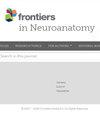Glycine is a transmitter in the human and chimpanzee cochlear nuclei
IF 2.1
4区 医学
Q1 ANATOMY & MORPHOLOGY
引用次数: 0
Abstract
IntroductionAuditory information is relayed from the cochlea via the eighth cranial nerve to the dorsal and ventral cochlear nuclei (DCN, VCN). The organization, neurochemistry and circuitry of the cochlear nuclei (CN) have been studied in many species. It is well-established that glycine is an inhibitory transmitter in the CN of rodents and cats, with glycinergic cells in the DCN and VCN. There are, however, major differences in the laminar and cellular organization of the DCN between humans (and other primates) and rodents and cats. We therefore asked whether there might also be differences in glycinergic neurotransmission in the CN.MethodsWe studied brainstem sections from humans, chimpanzees, and cats. We used antibodies to glycine receptors (GLYR) to identify neurons receiving glycinergic input, and antibodies to the neuronal glycine transporter (GLYT2) to immunolabel glycinergic axons and terminals. We also examined archival sections immunostained for calretinin (CR) and nonphosphorylated neurofilament protein (NPNFP) to try to locate the octopus cell area (OCA), a region in the VCN that rodents has minimal glycinergic input.ResultsIn humans and chimpanzees we found widespread immunolabel for glycine receptors in DCN and in the posterior (PVCN) and anterior (AVCN) divisions of the VCN. We found a parallel distribution of GLYT2-immunolabeled fibers and puncta. The data also suggest that, as in rodents, a region containing octopus cells in cats, humans and chimpanzees has little glycinergic input.DiscussionOur results show that glycine is a major transmitter in the human and chimpanzee CN, despite the species differences in DCN organization. The sources of the glycinergic input to the CN in humans and chimpanzees are not known.甘氨酸是人类和黑猩猩耳蜗核的一种递质
引言 听觉信息从耳蜗经由第八颅神经传递到背侧和腹侧耳蜗核(DCN、VCN)。许多物种都对耳蜗核(CN)的组织、神经化学和电路进行过研究。在啮齿动物和猫的耳蜗核中,甘氨酸是一种抑制性递质,在 DCN 和 VCN 中都有甘氨酸能细胞。然而,人类(及其他灵长类动物)与啮齿动物和猫在直流神经网的层状和细胞组织上存在很大差异。因此,我们提出了一个问题:CN 中的甘氨酸能神经递质是否也存在差异?方法我们研究了人类、黑猩猩和猫的脑干切片。我们使用甘氨酸受体(GLYR)抗体识别接受甘氨酸能输入的神经元,并使用神经元甘氨酸转运体(GLYT2)抗体免疫标记甘氨酸能轴突和末梢。我们还检查了免疫染色钙黄绿素(CR)和非磷酸化神经丝蛋白(NPNFP)的档案切片,试图确定章鱼细胞区(OCA)的位置,章鱼细胞区是啮齿类动物VCN中甘氨酸能输入最小的区域。结果在人类和黑猩猩中,我们发现DCN以及VCN的后部(PVCN)和前部(AVCN)中广泛存在甘氨酸受体免疫标记。我们发现 GLYT2 免疫标记的纤维和点状物呈平行分布。这些数据还表明,与啮齿类动物一样,猫、人和黑猩猩中含有章鱼细胞的区域几乎没有甘氨酸能输入。讨论我们的研究结果表明,尽管DCN的组织结构存在物种差异,但甘氨酸是人和黑猩猩CN的主要递质。人类和黑猩猩神经中枢的甘氨酸能输入来源尚不清楚。
本文章由计算机程序翻译,如有差异,请以英文原文为准。
求助全文
约1分钟内获得全文
求助全文
来源期刊

Frontiers in Neuroanatomy
ANATOMY & MORPHOLOGY-NEUROSCIENCES
CiteScore
4.70
自引率
3.40%
发文量
122
审稿时长
>12 weeks
期刊介绍:
Frontiers in Neuroanatomy publishes rigorously peer-reviewed research revealing important aspects of the anatomical organization of all nervous systems across all species. Specialty Chief Editor Javier DeFelipe at the Cajal Institute (CSIC) is supported by an outstanding Editorial Board of international experts. This multidisciplinary open-access journal is at the forefront of disseminating and communicating scientific knowledge and impactful discoveries to researchers, academics, clinicians and the public worldwide.
 求助内容:
求助内容: 应助结果提醒方式:
应助结果提醒方式:


